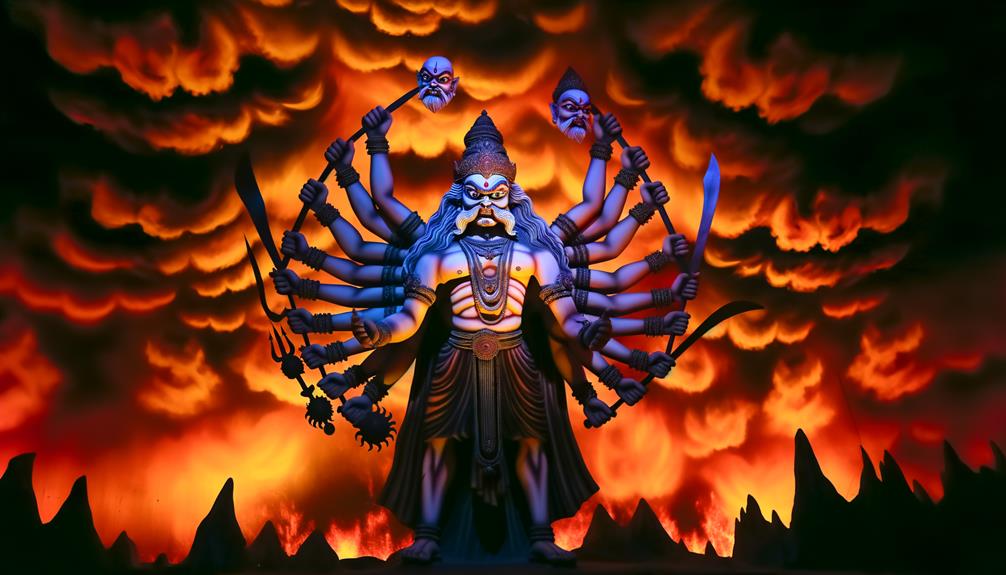When looking at the intricate world of Hindu mythology, I'm drawn to one figure who really stands out – Ravana, the Epic Demon King. Trying to understand him is like trying to find your way through a maze. He's full of contradictions that make you question typical ideas of right and wrong.
As someone who studies this stuff, I'm really intrigued by this ten-headed ruler. It's not just his power and intelligence, but the deep meanings he represents in the famous story of the Ramayana. Ravana isn't just a bad guy, despite his reputation. He's a dedicated follower of Shiva, a knowledgeable scholar, and a good leader.
But how did this kind of character get labelled as evil in the story? What's really going on with this epic demon king? Let's look into this together. We'll peel away the myths and the history to uncover the mystery that is Ravana.
The Intriguing Birth of Ravana

Let's dive into the captivating story of Ravana's birth. Contrary to popular belief, Ravana wasn't always a demon, nor was he born evil. His transformation into a demon king, the primary villain of the Hindu epic Ramayana, is a compelling story deeply rooted in Hindu mythology.
Ravana was the offspring of Pulastya, a respected sage, and Kaikesi, the daughter of Sumali, a demon. This lineage combined both divinity and demonhood, making him a unique entity. This blend resulted in him having ten heads and twenty arms, a symbol of his immense knowledge and power. But despite his birth, Ravana wasn't inherently evil. He was a devout follower of Lord Shiva and a knowledgeable scholar whose ego unfortunately clouded his wisdom.
Ravana, as the ruler of the kingdom of Lanka, was known for his prosperous and powerful reign. However, his insatiable desire for power and indifference towards dharma set him on a path towards ruin. His story reminds us that power, when mixed with pride, can lead to one's downfall. Ravana's tale offers a profound understanding of his character, showing him as more than just a demon king.
Ravana: The Devout Follower of Shiva
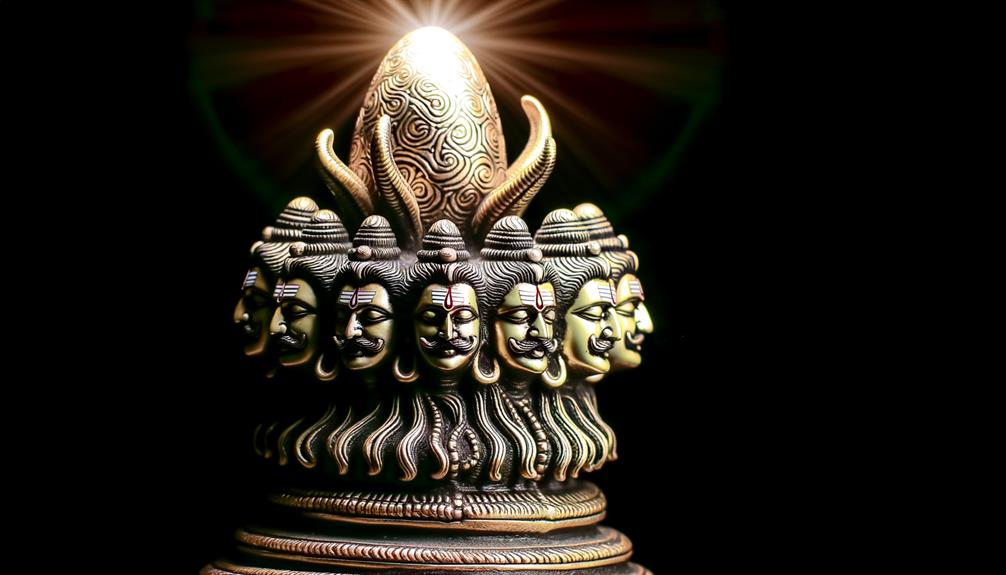
Ravana, despite his notorious image, is actually a dedicated disciple of Lord Shiva. This side of Ravana, often overshadowed in the vast epic of the Ramayana, enriches his character, showing him as someone with an intricate personality. Ravana, as an ardent devotee of Shiva, is recognized for his deep knowledge and comprehension of Hindu scriptures, which is evident in his worship of Shiva.
Ravana's scholarly and musical talents are epitomized in the Shiva Tandava Stotra, a hymn he created in honor of Shiva, while skillfully playing the Veena, an Indian musical instrument. His praise for Shiva not only speaks volumes about his devotion but also sheds light on his intellectual capabilities.
The History Encyclopedia narrates an incident where Ravana, in a bold move, tried to lift Mount Kailash, Shiva's dwelling place, to display his strength. Shiva, in response, forced the mountain back down, entrapping Ravana underneath. This episode underlines the complexity of Ravana's character, a mix of boldness, intelligence, and steadfast devotion.
Recognizing the many facets of Ravana's character takes us beyond the single-dimensional view of him as a villain, reinforcing the intricate nature of characters in the colorful narrative of the Ramayana.
Battles and Conflicts Involving Ravana
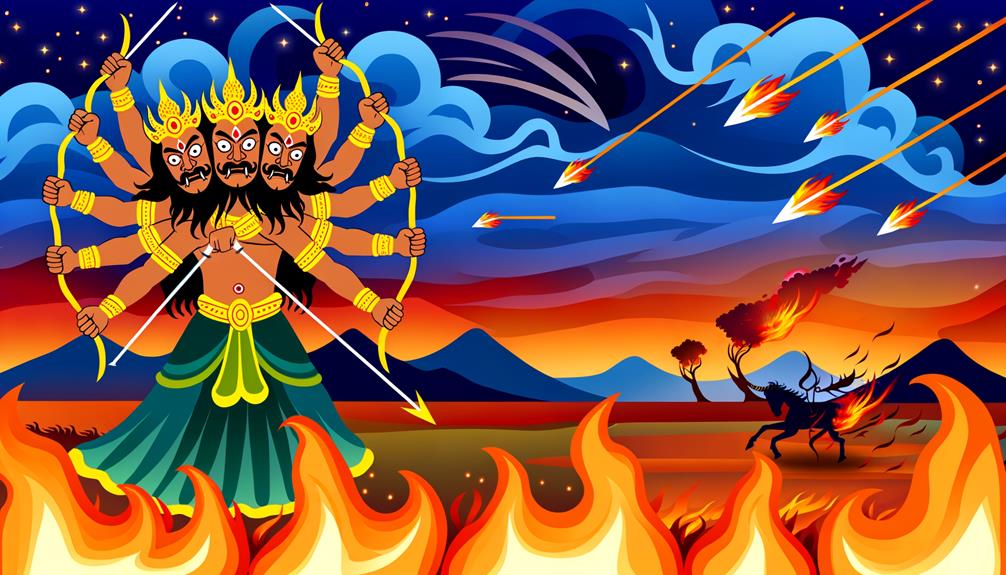
Ravana, the notorious demon king of Lanka, was famously embroiled in an array of battles and conflicts. These encounters highlight his aggressive tendencies and clever battle strategies, both of which are key elements of his persona in the epic tale of Ramayana. You might recognize Ravana from his clash with Rama. Their tale kicks off with Ravana kidnapping Sita, Rama's spouse. This act of aggression ignited a brutal war, ending with Lord Rama's triumph, a pivotal moment in this legendary saga.
Ravana's war record, however, isn't just limited to his face-off with Rama. He also took on Kartavirya Arjuna and King Mandhata but was defeated in both battles. Additionally, his invasion attempt of Vaikuntha was unsuccessful.
Here's a brief rundown of his major showdowns:
| Battle | Result |
|---|---|
| Rama and Ravana | Lord Rama won |
| Ravana and Kartavirya Arjuna | Ravana was defeated |
| Ravana and Mandhata | Ravana was defeated |
| Ravana's invasion of Vaikuntha | Ravana's attempt failed |
Ravana's stories are a fundamental part of the mythology of the Indian subcontinent. They present him as a multifaceted character, a blend of heroic and villainous traits.
Worship and Temples of Ravana
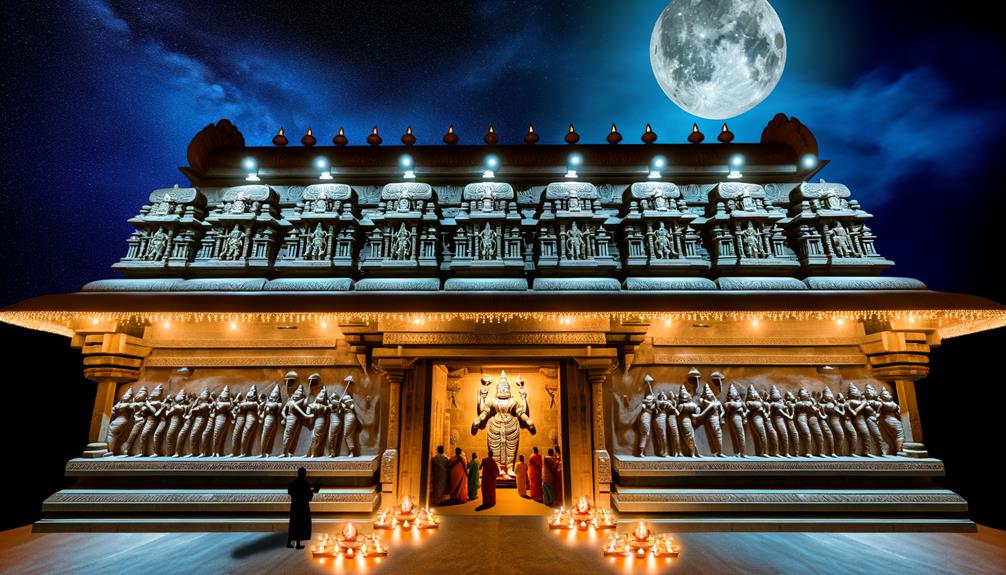
Ravana, a complex figure from the Ramayana, holds a sacred role in some parts of India and Sri Lanka. His influence isn't just limited to his notorious conflict with Lord Rama, the king of Ayodhya, or his desire for Rama's wife, Sita. As the mighty King of Lanka, his story goes much further.
People pay homage to Ravana due to the rich tapestry of good and evil woven into the ancient Indian narrative. Even though he's usually the bad guy in the Ramayana, Ravana's followers visit temples in Bisrakh, Agra, and other locations to ask for his blessings. This respect shows an interesting side of Ravana, who wasn't only a strong demon king but also a dedicated admirer of Shiva and Parvati.
That said, not everyone sees Ravana in the same light. For instance, the Ravana Dahan ritual, which involves burning effigies of Ravana during Dussehra, is met with resistance in some areas of Agra. This range of views reflects the different opinions about Ravana's legacy. It shows how the interpretation of mythology can often resemble the complexity of human nature.
Ravana's Influence on Culture and Art
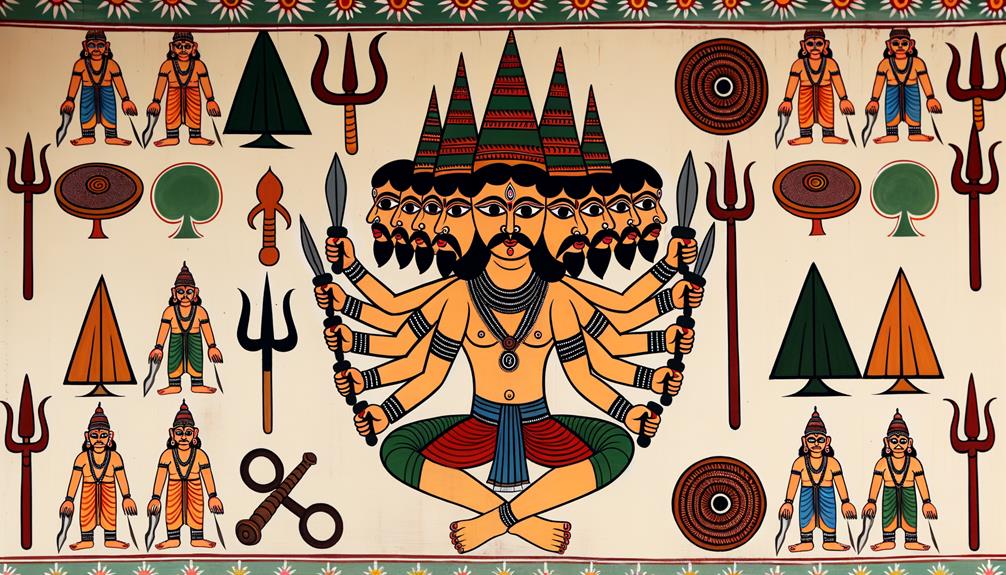
Let's talk about the powerful influence of Ravana, the infamous demon king of the Ravana epic, on culture and art.
This character from ancient Hindu stories continues to shape various fields, including social sciences and both visual and performing arts.
Take Sri Lanka, for instance, once known as Lanka. Here, countless works of art have been inspired by Ravana's devotion to Lord Shiva. These works, often found in Rajasthani paintings and sculptures, frequently depict the number 73, a figure representing the years Ravana spent in worship of Shiva.
The Hindu festival, Ram Lila, is a vivid example of Ravana's enduring cultural impact. The event climaxes with the burning of Ravana effigies, a symbol of good prevailing over evil.
Ravana's character and cultural significance are still topics of debate among modern Tamil groups. Their interpretations and praises of Ravana, combined with the re-telling of his story in various forms of art such as literature, music, dance, and theatre, highlight the lasting effect of this epic demon king on Indian culture and art.
Frequently Asked Questions
Was Ravana a Demon King?
Sure, Ravana is often referred to as a demon king in the stories of Hindu mythology. His character is portrayed as a ten-headed sovereign of Lanka. Even though he's highly educated and a devoted follower of Lord Shiva, he's still seen as a symbol of evil. His downfall? His inflated ego and his deeds. Despite his knowledge and devotion, his pride and actions are what label him as a negative figure.
What Is Ravana the Demon Of?
So, you're curious about Ravana from Hindu mythology? Well, it's important to note that he isn't exactly a 'demon' in the way you might think. Actually, Ravana is more like a mighty king who happens to possess some demonic traits. He's most recognized for his ten heads and the notorious act of kidnapping Sita. Interestingly, he stands as a symbol of the victory of good over evil. Quite fascinating, isn't it?
Why Is Ravana Called an Evil King?
Why do people label Ravana as a wicked king? Well, it's mainly because of his morally wrong actions, like kidnapping Sita. Even though he was quite wise, his negative qualities such as greed and arrogance often took center stage, outshining any good qualities he might have had. That's why he's often tagged as 'evil' in Hindu mythological stories.
What Is the Legend of King Ravana?
Alright, let's chat about the story of King Ravana. It's quite a tale! Picture a king with ten heads, pretty wild, right? Now, this King Ravana was no ordinary monarch. He was a demon king, known for his deep knowledge and unwavering devotion to Lord Shiva. So, you might be wondering, where does the story take a dark turn? Well, Ravana goes ahead and kidnaps Sita. This sets off a huge battle with Rama. The twist here? King Ravana, in all his might and wisdom, ends up being a symbol of how unchecked desires can lead to one's downfall. That's the legend of King Ravana for you!
Conclusion
Let's talk about Ravana, the ten-headed demon king. His story is a fascinating mix of myth, worship, struggle, and cultural impact.
Sure, he's often painted as the bad guy, but did you know there are parts of India that actually revere him? It's an interesting balance, isn't it?
The story of his life reminds us that no one, not even the most powerful, are immune to downfall. This makes him an essential player in the age-old battle between good and evil.

